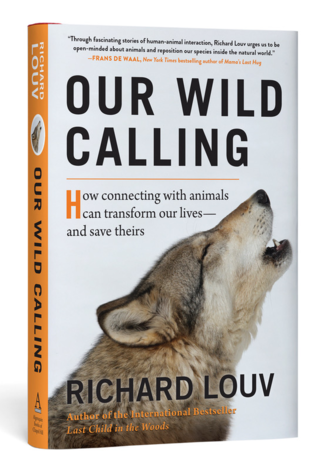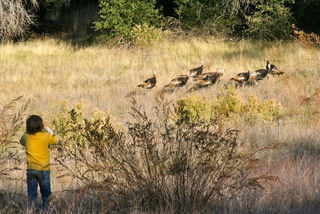Loneliness
"Our Wild Calling" by Richard Louv Is a Game Changer
Book review: Connecting with animals can transform our lives―and save theirs.
Posted November 4, 2019 Reviewed by Lybi Ma
A few months ago I was asked to write an endorsement for Richard Louv's forthcoming book, Our Wild Calling: How Connecting with Animals Can Transform Our Lives―and Save Theirs. I jumped at the opportunity and couldn't wait for the book to be available. Now that Our Wild Calling has been published, I'm thrilled that Rich, who coined the now-iconic phrase “nature-deficit disorder,” was able to answer a few questions about his new, game-changing book. Our interview follows:
Why did you write Our Wild Calling?

In the introduction to the book, I describe an encounter with a large fox on a trail in Alaska when time seemed to stop. Without going into detail here, I can say those moments, for me, held an unexpected transformational quality. Later, I recalled similar moments and deeply meaningful relationships with other animals, including my dog when I was a boy.
Over time, I asked others about their encounters. Friends, colleagues, and strangers of different ages and cultures and professions—including psychologists scientists, theologians, trackers, teachers, physicians, traditional healers, and one polar explorer—they all had stories to tell, ones that, to them, held great meaning, which grew deeper with the telling.
Lisa Donahue, a mother in Toronto, told me how she walked into her dining room one day and saw her six-year-old son and their large retriever, Jack, stretched out together on the dining room carpet. The boy was stroking the dog’s side. Then she heard her son say quietly, matter-of-factly, “Mommy, I don’t have a heart anymore.” Startled, Lisa asked her son what he meant. He said, “My heart is in Jack.”
This permeability of the heart (or soul or spirit or neurological connection) occurs naturally when we’re very young, with companion animals but also with wild animals. Some people continue to experience it throughout their life, though they may have no words for it. This book is an attempt to describe what I came to call the habitat of the heart.
How does it follow up on your previous interests and books?
While researching Last Child in the Woods about “nature-deficit disorder,” my term for the price humans pay for their alienation from the rest of nature, I found surprisingly few scientific studies about the impact of nature experiences on human health and development. Since then, the research has grown exponentially—from a handful to approximately 1000 studies, abstracted in the Children & Nature Network Research Library.
The majority of this research focuses on green environments. Regarding animals, the majority of existing research focuses on animal-assisted therapy. But research on the impact of wild animals on human well-being is thin. Surprisingly little research has been done on the therapeutic impact of wild animals on human health and well-being, or on how we communicate with them. This may be the next frontier in rebuilding our relationship with our other-than-human relatives. This is particularly important as people and wild animals live in increasingly close proximity, including in our cities. It’s also important because the emotional or spiritual base of environmentalism needs strengthening, and wildlife does elicit deep emotion.
For conservation, education, health, urban planning and more, the potential is there to reset our relationship with animals, who comprise our larger family.

What are some of your major messages?
The messages in this book are offered mainly through the stories of others: an oceanographer whose worldview is changed by a dangerous encounter with a giant octopus, a man who teaches people to understand bird language, a boy who learned ethics from his dog, the owner of an eco-cruise line who says elephants taught him everything he ever needed to know about business, a remarkable young woman on the autism spectrum and her equally remarkable service dog, and many more.
The themes range from the altered states we experience in deep connection with other animals, to the ways that animals communicate with each other and across the divide of species, to ways we can achieve deeper knowledge and connection with animals. For example, in the 1980s, biopsychologist Gordon Burghardt introduced the concept and process of what he calls “critical anthropomorphism.” Today, his work centers primarily on reptile behavior and animal play. Using a kind of deep empathy, Burghardt and other scientists practice a technique that, to me, seems similar to method acting; they “wear the shoes of the snake,” as he puts it, with a touch of humor; and by doing this they become better scientists.
Developing deeper connections with animals could be a detour around the Anthropocene, a human-dominated age that Harvard scientist E. O. Wilson has dubbed the age of loneliness and what you, Marc, refer to as “the rage of inhumanity.” In Our Wild Calling, I make the case for an alternative future—an age of connectedness (what Glenn Albrecht calls the Symbiocene and Thomas Berry called the Ecozoic Era).
Indeed, one of my primary themes is human loneliness. Alarming new research suggests the growth of what some health officials call an epidemic of social isolation, which may be equal to or exceeds other well-accepted risk factors such as obesity for early death. This isolation is attributed to several causes—among them, an excess of social media and the withering of real social capital. I contend our human loneliness is rooted in deeper species loneliness.
Research shows that the urban parks that have the best impact on human psychological health are the parks with the highest biodiversity—the widest array of animal and plant species. I don’t believe that’s an accident. As a species, we are desperate to know that we are not alone in the universe. And yet, intimacy—or the potential for intimacy—is all around us.
I should add here that, as you know, I’ve always been impressed by your work, and with the thinking of such writers and thinkers as Carl Safina and Frans de Waal on the intelligence and emotions of other animals. I hope Our Wild Calling stimulates more appreciation for how animals shape us, how we shape them, and how to better protect them.
What are some practical applications of your new work?
In this field, practical applications are already in place, such as animal-assisted therapy, animal rescue centers, and biophilic urban planning—including the creation of wildlife corridors. As we work to protect wild habitat and make our cities more biodiverse, new jobs and careers in wildlife management and wildlife nurturing and planning could be developed. Along this line, one project I’m involved with is Cities Connecting Children with Nature, a partnership between the Children & Nature Network and the National League of Cities, which is working to increase nature connection and more natural habitat in urban areas.
Opportunities in education are enormous. For example, what if the practice of critical anthropomorphism—for better science learning—could be taught in public schools? Or deeper incorporation of Indigenous ways of learning about nature? At the individual level, many people are replanting their yards with native plant species, which reboots the local food chain or participating in the National Wildlife Federation’s Certified Wildlife Habitat effort, or Audubon’s Christmas Bird Count, and other programs.

Of course, birdwatching and the broader hobby of wild watching appear to be growing in popularity, particularly among millennials. Condé Nast Traveller described birding as “2017’s unlikeliest craze.” The Telegraph reported that 32 percent of British men ages 16 to 25 have been birding. (The headline for that piece was “The rise of the hipster bird-watcher,” which may or may not be of help.)
Our Wild Calling also supports this idea. Just as communities create Neighborhood Watch groups to prevent human crime, we could launch Neighborhood Wildlife Watch groups (a British organization, Wildlife Watch, helps people create wildlife watching clubs). Even in the most populated urban neighborhoods, members of such groups could track the influx of wild animals, prevent dangerous encounters, and record the exit of animal refugees from climate change. They could volunteer at urban wildlife rehabilitation and pet rescue centers. Such efforts would give people a greater investment in their regional and personal identity and the psychological well-being and confidence that comes with that.
In these ways and more, building human-nature social capital would reduce species loneliness and increase hope for the survival of the children of all species.
Are you hopeful more and more people will respond to their "wild calling" in the future and these connections will help save our planet and them as well, and why or why not?
Despair has its uses as a motivator, but I’ve always believed that there’s no practical alternative to hope. Having said that, the news isn’t good. A few weeks ago, researchers reported in the journal Science that the number of birds in the United States and Canada has fallen by nearly 30 percent just since 1970—which translates to 2.9 billion fewer birds. At the same time, we see the rapid emergence of what I refer to as the Replacements: robot dogs as pets, digitally “enhanced” animals, the creation of creatures combining the traits and parts of humans and other animals.
In some cases, technology can help us connect. For example, crowd use of the internet to enlist thousands of citizen naturalists who count birds and track the growth or reduction of biodiversity. But blind faith in technological life, and more so the climate crisis and unchecked habitat destruction endanger not only our relationship with other species but life itself.
For millennia, our species has waged war on nature, and our isolation and pathologies have only grown. Now it's time to make peace, as individuals and as a species. Our ways may be awkward and searching, but we must do this. We know empathy is more powerful than technology. In the time we still have, this is our wild calling.
________
Thanks, Rich, for such an inspiring interview about your new book. I'm sure it'll be another game-changer and will be of interest to a wide array of people, including conservation psychologists. I hope it enjoys a broad global audience because the topics with which you're concerned know of no geographical or cultural borders. We are, as noted author Bill McKibben puts, it, "animals in a world of animals."
References
Children & Nature Network Research Library.
Bekoff, Marc. Earth Emotions: New Words for a New World. (An interview with Glenn Albrecht about his new book and solastalgia.)
_____. Rewilding Our Hearts: Building Pathways of Compassion and Coexistence. New World Library, Novato, California, 2014
_____. Animal Emotions: Exploring Passionate Natures. BioScience 50, 861-870, 2000. (A discussion of critical anthropomorphism and biocentric anthropomorphism.)
____. Anthropomorphic Double-Talk: Can Animals Be Happy But Not Unhappy? No!




